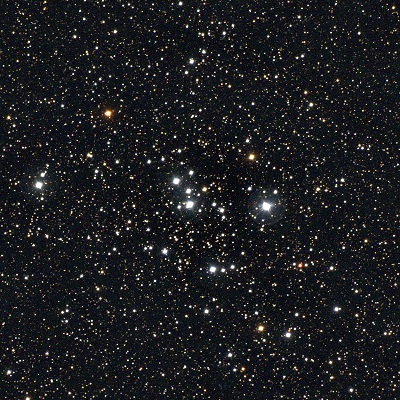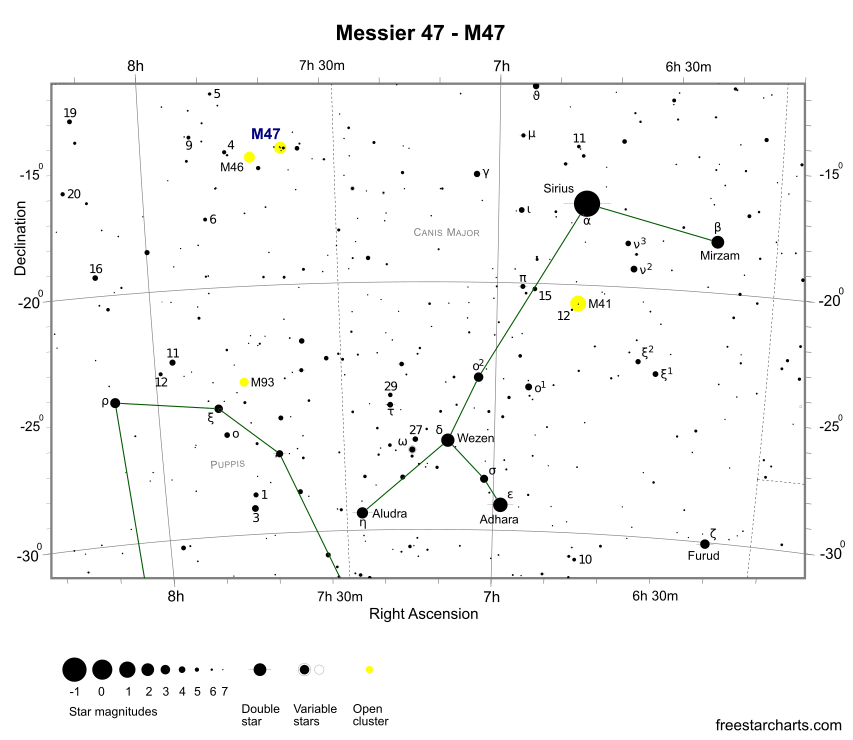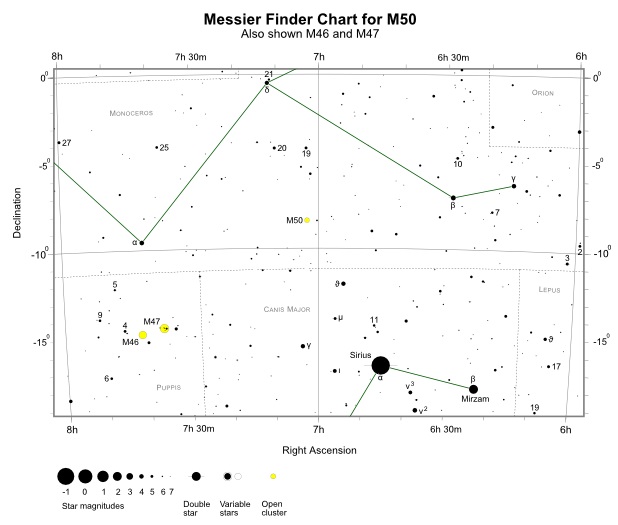M47 is a bright, loose naked eye, open cluster located in the Milky Way star fields of the constellation of Puppis. It was discovered by Giovanni Batista Hodierna before 1654 and independently by Charles Messier on February 19, 1771. The cluster is best seen from southern and equatorial latitudes during the months of December, January and February.
Finding M47 is quite easy, since Sirius (mag. -1.46), the brightest star in the night-time sky is near by. To do this, imagine a line connecting Mirzam (mag. +1.98) with Sirius and extend it for 14 degrees in a north-easterly direction to arrive at the cluster. Just over a degree to the southeast of M47, and in the same binocular field of view, is another Messier open cluster, M46. Both clusters have about the same apparent size (approx. 0.5 degrees) although M47 is noticeably brighter. A third Messier cluster in Puppis, M93, is located about 9 degrees south of the M46, M47 pair.


Finder Chart for M47 - pdf format (credit:- freestarcharts)

Finder Chart for M50 (also shown M46 and M47) - pdf format (credit:- freestarcharts)
M47 appears as a large fuzzy patch of light to the naked eye, with the brightest stars just about resolvable under dark skies. With 10x50 binoculars, it's an easy object. There are about 10 to 15 bright stars visible with at least half a dozen fainter other ones, spread over a diameter of 30 arc minutes. Larger 20x80 binoculars or small scopes reveal a myriad of fainter stars of varying magnitudes, interspersed between the brighter cluster members. Also visible in the same wide field of view is M46 and another open cluster NGC 2423 (7th magnitude), located 0.5 degrees north of M47. In stark contrast to M47, M46 is a compact cluster with many more stars visible. However, this pair of clusters do form a fine double act in binoculars and small scopes.
A 150mm (6-inch) telescope, at low magnifications, reveals M47 as a large loose cluster with around a dozen brighter members. In addition, tens of fainter members can also be seen. A very close double star of equal magnitude components lies near the centre of the cluster (Sigma 1121). The two stars shine at mag. +7.9 and are separated by 7.4 arc seconds. In total, M47 contains about 50 stars.
M47 has an interesting history in that although Charles Messier discovered the cluster on the same night he discovered M46 (February 19, 1771), it later emerged that Giovanni Batista Hodierna had observed M47 sometime before 1654. Credit is now usually given to both men regarding the discovery. In another twist, Messier described M47 "as a cluster of stars brighter than those of apparently neighboured M46", but made a sign error when recording its position. Subsequently, M47 was regarded as a missing object until T.F. Morris identified it in 1959 (together with another missing object M48).
M47 is a nice bright loose open cluster located in the constellation of Puppis. It's 1,600 light-years from Earth, easily visible to the naked eye and a superb view in binoculars or small telescopes. The cluster contains a handful of bright stars and many dozen fainter ones. In the same wide field of view is, the fainter but much more compact cluster, M46.
M47 Data Table
| Messier | 47 |
|---|---|
| NGC | 2422 |
| Object Type | Open Cluster |
| Constellation | Puppis |
| Distance (light-years) | 1,600 |
| Apparent Mag. | +4.3 |
| RA (J2000) | 07h 36m 35s |
| DEC (J2000) | -14d 28m 57s |
| Apparent Size (arc mins) | 30 x 30 |
| Radius (light-years) | 6 |
| Age (years) | 78 Million |
| Number of Stars | 50 |
| Other Name | Collinder 152 |